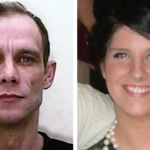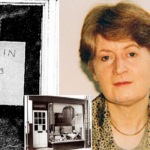The Operation Blue CORAL Fiasco (1)
by TIM HICKS & CHRIS CLARK
~~~~~
For some time, both authors have been investigating the murder of Mrs Trevaline Evans (pictured above) in Llangollen, North Wales in June 1990.
Their investigation has revealed police corruption and a catalogue of inexcusable investigative, intelligence, organisational, media operations and governance errors by North Wales Police (NWP) and other forces, which they believe prevented her murder from being solved. They have concluded that:
- The investigations into Trevaline’s murder from 1990 to the present day were catastrophically bungled.
- That had the investigation been conducted competently, Trevaline’s murder could have been solved.
- Trevaline could have been abducted and murdered by serial killer Christopher Halliwell. Who they also believe is also responsible for the murder of Claudia Lawrence, who was abducted in York in 2009.
- The murder may still be solvable.
Halliwell is currently in prison on a full life sentence for the 2003 murder of Becky Godden-Edwards and the 2011 murder of Sian O’Callaghan. He was a virulent misogynist from 1979 onwards aged 15. When he was in prison between 1985 and 1987 he boasted to a cell mate that he had already killed one woman and wanted to become a serial killer.
In their article Halliwell: The North West Clusters, the authors analysed a series of murders in the North West of England and linked Trevaline’s murder to them. In the three articles in this series, the authors analyse the various investigations that have taken place into Trevaline’s murder and the reasons they failed.
Trevaline’s Disappearance
Trevaline was aged fifty-two, married and ran an antique shop in Llangollen, North Wales. She and her husband Richard (pictured above, right inset) lived in Llangollen and had a Bungalow at Rhuddlan to which they were refurbishing and intended to retire.
On Saturday 16th June 1990, she vanished.
Trevaline is pictured in the lead illustration, along with a picture of her shop in Llangollen and the note on the front door the shop “Back in two minutes” left in the window on the day of her disappearance.
When Trevaline failed to return home, members of her family entered the shop and found the front door locked with the note still on the front door. Her handbag with her credit cards, car keys, coat and other items were still in the shop. Her powder compact was open on the counter. At that point she was reported missing.
The Initial Investigation: 1990
NWP concluded immediately that Mrs Evans had been abducted and the NWP Force Major Incident Team (FMIT) led the investigation. It established that Trevaline left the shop at 12.40pm. She was seen near her home at Market Street, Llangollen at 2.30 p.m., which is the last confirmed sighting of her alive. There were two other sightings of her that afternoon next to the River Dee, but they may not be accurate.
Despite an intensive search in Llangollen, of the River Dee and the nearby Shropshire Union Canal, and interviewing every householder in Llangollen, no trace of her, her clothes or the large amount of cash she had on her was ever found.
NWP concluded that Trevaline had been abducted and murdered but did not declare it as a murder, preferring to run the investigation as a missing persons enquiry. (Major Investigative Failure (MIF1). This meant the investigation did not comply from the normal standards of murder enquiries for documentation, management or external reviews (MIF2).
The case attracted huge public and media interest. NWP made appeals for information and the case was covered on the BBC TV programme Crimewatch UK twice. The Crimewatch reconstruction can be viewed here. It starts at 30 minutes and skilfully reconstructs the facts of her disappearance. Please take the time to watch it before reading further.
As with the Yorkshire Ripper investigation, the extensive media coverage generated an enormous number of leads and pieces of information to the Incident Room at Llangollen Police Station. One of these was a man who said he had seen a man with a camper van acting suspiciously at a local beauty spot called Horseshoe Pass and near Trevaline’s shop. The description of this man resembled Christopher Halliwell, who was unknown to the police for this type of crime at that time. The witness was interviewed by detectives at Llangollen Police Station, who ignored his evidence and did not follow up on either the description of the man or the van (MIF3), or interview his workmate who had also seen this man (MIF4). Had an appeal been put out locally for the van there is no doubt that it would have been traced. This was to emerge in 2023 as a catastrophic failure.
This was arguably the largest and most complex investigation that NWP had ever undertaken. NWP is a small county force with only a very small detective branch. To put this in context, in 2023 it had 309 detectives of whom only 12 served in the FMIT. North Wales is primarily rural and does not have any large urban centres. Consequently NWP detectives were not as experienced as detectives from the larger Metropolitan forces such as Greater Manchester, Merseyside, or the Metropolitan Police etc. and had very little experience of running large, complex, national investigations. Despite this, NWP did not request extra manpower from neighbouring forces. (MIF5). Nor did it request an external review from a senior detective from another force. (MIF6).
In 1986, following the failure of the Yorkshire Ripper investigation a new computer system called Home Office Large Major Enquiry System (HOLMES) was introduced to all forces. It was fully operational by 1988 and was intended to ensure that all leads were followed up and that Incident Rooms were not overwhelmed with huge amounts of information, as happened in the Yorkshire Ripper investigation.
However, HOLMES requires a central specialist team of operators and NWP may not have had the manpower to run a HOLMES incident room. Because FMIT ran the Trevaline Evans investigation as a missing person enquiry, not a murder investigation, it may have used this to evade the requirement to use HOLMES, preferring to run the investigation using card indexes which failed so spectacularly in the Yorkshire Ripper investigation (MIF7). This may be why the information from the witness was ignored and the van not traced. The authors have no doubt that other leads from the public were also subsumed in the card indexes and not followed up (MIF8).
During the Crimewatch program NWP issued appeals for four men to come forward and be eliminated. Trevaline had been seen several times in the company of one particular man, so NWP issued a photofit of him which was circulated widely and shown on Crimewatch UK. It was obvious that he was the prime suspect.
The photofit was instantly recognised locally as Trevaline’s innocent brother, Phil.
Every member of Trevaline’s family should have been identified and interviewed in the first days of the investigation. However, this did not happen (MIF9). As a result of this failure, Phil was prematurely designated as a suspect (MIF 10) and a huge amount of effort was wasted trying to trace a prime suspect who was entirely innocent.
Rather than admit that the suspect was of a member of the family and therefore irrelevant, NWP issued a statement that the photofit was “inaccurate”, although in fact it was a very good likeness. This ensured that NWP was able to evade admitting that it had designated the wrong man as a prime suspect on national television and bungled the investigation, and gave the impression that the man in the photofit was still a suspect, although in fact he was not. This was a failure of media strategy. (MIF11)
A second Crimewatch UK program broadcast in October 1990 also covered Mrs Evans’ disappearance and can be seen here at 10 minutes. This revealed that NWP wanted to interview two other men who were seen with Trevaline.
The other five men were ever traced. The investigation eventually wound down. All subsequent investigations by NWP into Trevaline’s murder were conducted by officers from FMIT and the case was never subjected to impartial scrutiny by officers from a different team of detectives from NWP, or from a different force (MIF12). In short, FMIT was marking its own homework.
From 1990 to 2001, NWP maintained Trevaline as a missing person, not a murder victim. This ensured that her case would not appear as an unsolved murder, which helped to keep NWP’s unsolved serious crime figures low.
This also meant that the case was excluded from antecedent investigations by other forces (MIF13) and appears to have been forgotten.
Operation ENIGMA: 1996 -1998
Operation ENIGMA was a cross-force investigation involving twenty-six Police Forces to identify potential links between unsolved murders of sex workers or women that could have been mistaken as sex workers, to identify if they had been committed by a serial killer.
Details on Operation ENIGMA are scarce, but it is believed to have reviewed 207 unsolved murders of women from 1986 onwards. It found that 72 of them (35%) needed further investigation, demonstrating just how inadequate police investigations of prostitute killings (“Fish and chip” murders in police parlance) were. It identified 21 potential clusters of unsolved murders that had links and could have been committed by up to four serial killers.
Operation ENIGMA recognised that some serial killers of sex workers also attacked women who were not involved in any way in sex work, so non sex workers were also included in the investigation. The serial killer Alun Kyte (“The Midlands Ripper”) was linked to the murder of two prostitutes after raping a woman who was not a sex worker in Weston Super-Mare in 1997.
In their article Halliwell: The North West Clusters, the authors used route package and cluster analysis to link Halliwell to the murder of Trevaline Evans and a series of prostitute murders and disappearances in the Manchester and Merseyside between 1988 and 1998. All are within a 40 mile radius from Aughton Park where Halliwell had lived and have common characteristics with Christopher Halliwell’s modus operandi.
[See Table, here]
There is very little doubt that some or all of these cases were considered by Operation ENIGMA. The authors believe that Halliwell may be one of the four serial killers that Operation ENIGMA identified as operating in the Midlands and Merseyside, which are only a short distance from Llangollen.
[See Map, here]
Both Trevaline Evans and Manchester prostitute Helen Sage disappeared. However, because FMIT had recorded Trevaline as a missing person, not a murder victim, it was never considered by Operation ENIGMA (MIF14). Likewise, because Greater Manchester Police (GMP) was also manipulating its crime figures by recording the disappearance of Helen Sage as a missing person, her murder was also excluded from Operation ENIGMA (MIF15).
The policy of misclassifying murder victims as missing persons pursued by NWP and GMP withheld information from Operation ENIGMA. This prevented it from considering and linking these two crimes, which in turn undermined its effectiveness and may have prevented it from detecting Halliwell (MIF16).
If this is so, this will have helped Halliwell stay under the radar and go on to murder other women.
The authors are unable to estimate if there have been other instances of NWP and GMP concealing murders as missing persons enquiries, or if other forces follow or have followed this policy, the number of murders involved, or the impact this has had on other investigations.
Operation Blue CORAL: 2001 investigation
In January 2001, NWP re-opened the case under the codename Operation Blue CORAL. It was again conducted by FMIT, which covers both NWPs major investigations and cold case investigations. As part of this, Trevaline’s status was changed from a missing person to a murder victim on 8th January 2001.
The new investigation did not pursue the other five men who were identified in the 1990 Crimewatch appeals (MIF 17). Instead the FMIT detectives arrested Trevaline’s husband Richard in June 2001. This requires further analysis.
About 61% of women killed by men in the UK are killed by a current or ex-partner. Source: BBC. This has led to a presumption within the Police that when investigating the murder of a woman, the most likely suspect must be the husband or boyfriend and it is therefore appropriate to automatically arrest him.
There had been speculation that Trevaline and Richard had been having marital difficulties and that Trevaline was having affairs. However, no man has ever been identified as her lover. During the 1990 Crimewatch program, NWP described Trevaline as happily married and Richard Evans appears to have been eliminated as a suspect at the time.
There are plenty of marriages that have marital difficulties or where one or both parties are unfaithful to each other, which either resolve themselves over time into happy marriages, or result in a divorce in the normal lawful way. Therefore this is not enough on its own to justify a reasonable suspicion that Richard Evans had murdered Trevaline. Nevertheless, NWP arrested him in 2001.
Richard’s alibi was that he was in Rhuddlan working on the bungalow at the time of Trevaline’s disappearance, as normal. Unfortunately he did not have any witness to confirm his presence at Rhuddlan, which is only about an hour’s drive from Llangollen.
The FMIT did not interview the two witnesses that saw the man behaving suspiciously near Trevalines shop (MIF18 and MIF19), or try to trace the van (MIF20). Had all the information been entered into HOLMES, then he would have emerged as an open actions and HOLMES would have required that his evidence was followed up, the van traced and the action closed. It therefore appears that all the information produced by the original 1990 investigation was not fully entered onto HOLMES, or the information was not properly assessed (MIF21).
HOLMES was probably ignored, because FMIT was obsessively focussed on Richard Evans as the prime suspect and ignored all other lines of enquiry and suspects (MIF22). This is a type of investigative failure called confirmation bias, which is defined as “the tendency to search for, interpret, favour, and recall information in a way that confirms or supports one’s prior beliefs or values”.
Confirmation bias destroyed the Yorkshire Ripper investigation, because it focussed prematurely on the Ripper being a Geordie and then excluded all other suspects. HOLMES was intended to prevent this occurring again, but all lines of enquiry unrelated to Richard Evans appear to have been ignored by FMIT.
Predictably Richard was released without charge.
[Maps by FAD]
Coming next: The Operation Blue CORAL Fiasco (2)
Appeal for Information
Did you see Christopher Halliwell:
- Fishing along the River Dee?
- In Llangollen
- Fishing at Scarborough?
- Fishing at Whitby?
- Fishing along the River Tees?
- Fishing at Scaling Dam?
- In York driving a red Rover?
- At Ampleforth?
- At Oswaldkirk?
- In Middlesbrough?
- In Huddersfield?
- In Merseyside, driving a white D Reg van?
- At Aughton Park?
- In Manchester?
- In Sheffield?
- Did he drive you from Swindon to Sheffield or York University?
Please email letters@nyenquirer.uk. All enquiries will be treated in the strictest confidence.












